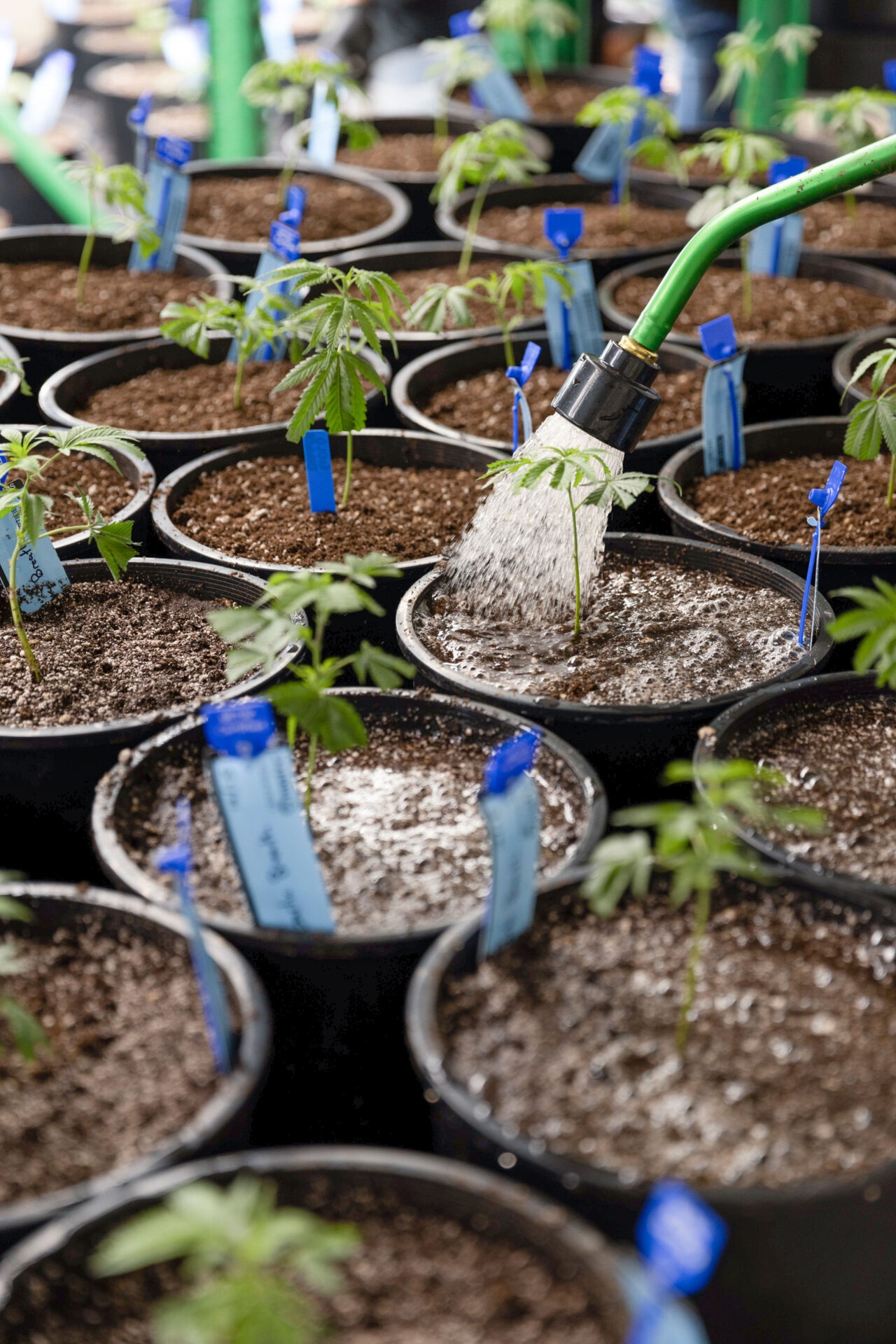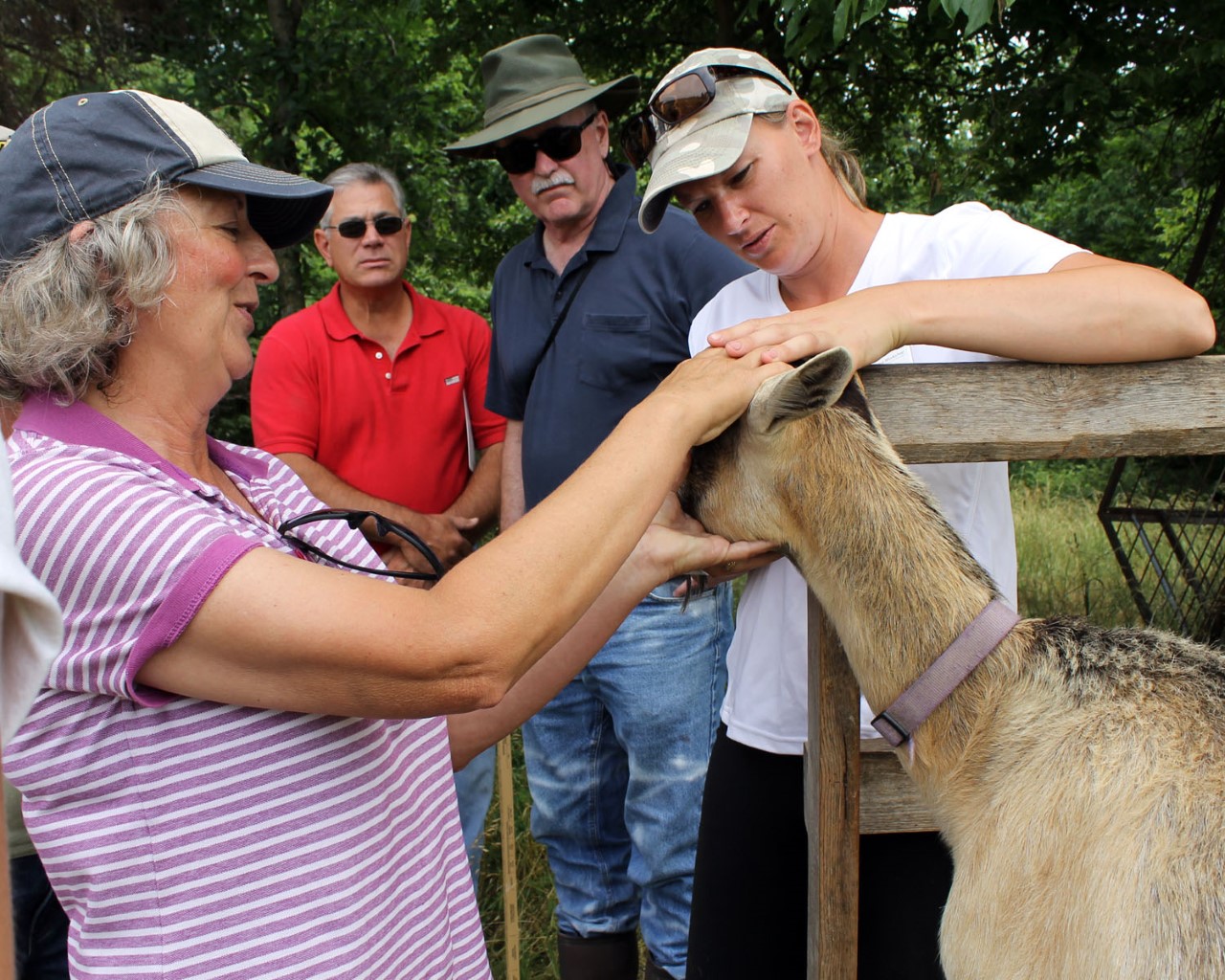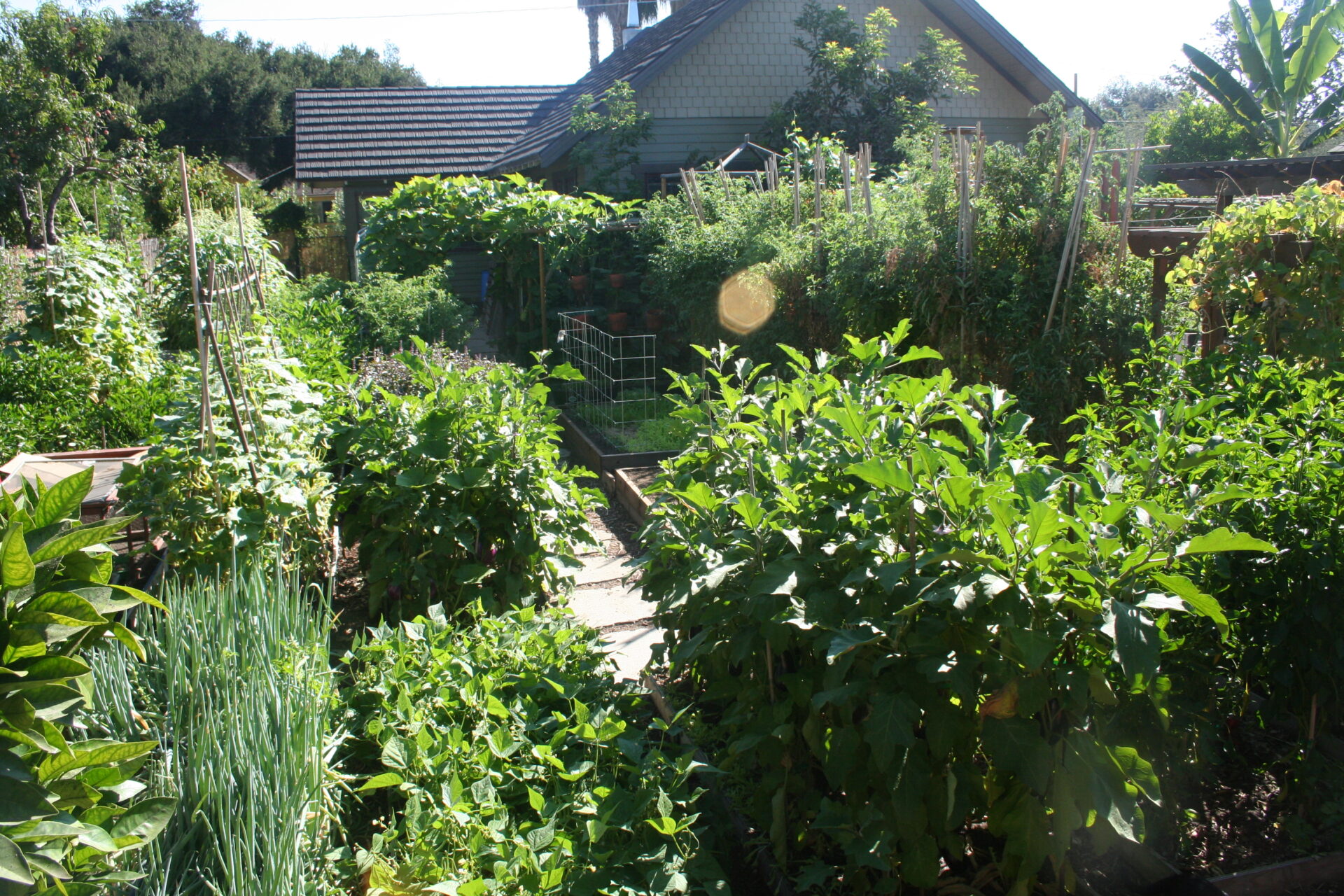
Conventional farming adopted in modern agriculture are mostly monoculture-based, relying heavily on the use of external chemical (for example: pesticides and fertilizers) inputs (Fig. 1). While these systems provide valuable agronomic benefits, they could result in declines of local and regional biodiversity, soil erosion, selection of pesticide resistance, greenhouse gas emissions, and eutrophication (depletion of oxygen in the water). Given the environmental impact of conventional agriculture, it is necessary to explore and develop alternative, more environmentally sensitive and resilient agricultural systems. There is a growing body of research regarding diversified organic and ecologically-based farming systems in California and other states (Fig. 2). Although the mechanical (for example: tilling and planting equipment) inputs used to control pest populations, maintain soil fertility, and prepare fields for planting in many organic farms have negative environmental effects such as soil erosion and nutrient loss, diversified organic farming helps enhancing biodiversity and ecosystem services (see Box #1). While the beneficial organisms provide a variety of ecosystem services, enhancing biodiversity can be both beneficial and detrimental to our crop productions. However, by focusing proper agroecosystem management such as habitat management for beneficial organisms can shift biotic communities away from pest species dominance. Following these ecosystem dynamics can reduce the need for farmer intervention or use of any synthetic external inputs.
Box # 1: What are ecosystem services?
Ecosystem services are the direct or indirect services or benefits that ecosystems provide to humankind. Ecosystem services can be divided into four major categories: (1) provisioning: food, fiber, fuel, and genetic resources; (2) regulating and mitigating: pollination services, disease and pest regulations, water quality, soil reclamation, climate stability, and greenhouse gas mitigation; (3) supporting: nutrient and water cycling, soil fertility, soil quality; and (5) aesthetic and cultural: spiritual and recreational benefits from rural views and landscapes [1]. Although difficult, the economic value of these services can be estimated, showing us the profit or loss that can be gained or lost from incorporating diversified organic and ecologically-based methods or adhering to a more corporate model with its incumbent financial risks. For example, global pollination services, in terms of monetary value, are more than $200 billion, annually [2]. In the US only, it is more than $70 billion [3]. If we monetize all the ecosystem services, the total value would be beyond our imagination.
What are the Advantages of Diversified Systems?
Diversified or biodiverse ecosystems are more structurally complex and stable than the simplified monoculture-based systems, and they are resistant to external disturbances including species invasions, diseases, and other disturbances. Different species respond uniquely towards any disturbance, so there is a higher chance that at least one species is highly productive against external disturbances. If all niches are already occupied in an ecosystem, external species cannot invade easily. Similarly, more diverse ecosystems contain many species with similar function (known as functional redundancy) which is crucial in providing the stability in the ecosystems. For example, in biodiverse ecosystems, if one species disappears, another species can perform the same function (known as the insurance effect) which helps to avoid ecosystem degradation and minimize future risk to agricultural production. This robustness in wild ecosystems is echoed in the crop resilience encountered in diversified farmed landscapes. Also, many species can coexist to facilitate each other’s growth while sharing resources. Furthermore, highly biodiverse communities may be able to tap resources more effectively because different species differ in strategies for resource acquisition.
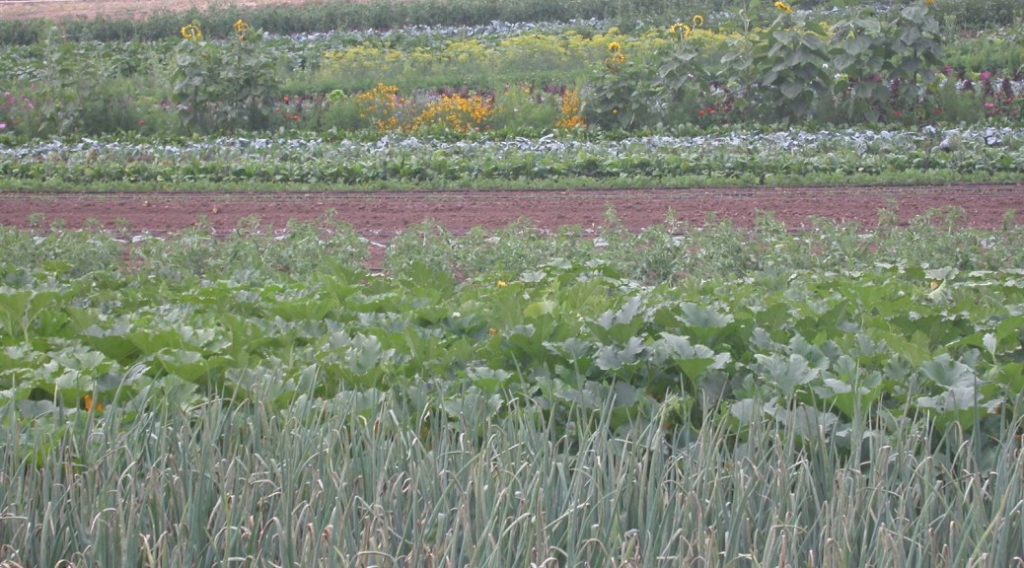
How can Ecosystem Services be Increased Through Diversified Organic Farming?
Farmers can manage their agricultural lands to support biodiversity and enhance the ecosystem services that biodiversity provides. One of several examples to increase biodiversity in these systems is intercropping. In intercropping, farmers select crops that do not compete strongly with each other and can benefit at least one of the crops. Intercropping can be beneficial since it helps to improve soils with nitrogen fixers, some deep-rooted species can benefit others by bringing nutrients and moisture up at the soil layers, and one species can provide shade, support, or nursery to others. One popular traditional example of intercropping is planting corn, beans, and pumpkin together. Corn plants provide support to beans, which fixes atmospheric nitrogen and supplies to soil that corn also uses. Similarly, both corn and bean together provide shade and humidity to pumpkin, which suppresses weeds and benefits to corn and beans too. Crop rotation is commonly used to break the lifecycle of many agricultural pests, which also increase farmland biodiversity. Studies have shown that beneficial soil microbial communities that support soil health is also greater in diversified organic farms, compared to monoculture-based conventional farms [4]. Cover cropping is another great way to diversify our cropping systems that helps to enhance soil health (e.g., enhance soil nutrients, soil structure, organic matter, and soil microbial community), reduce soil erosion, suppress weeds, and break pest cycles, while also supporting beneficial insects such as pollinators and natural enemies. Similarly, biodiversity in nearby uncultivated or semi-natural habitat patches also provides ecosystem services to cultivated fields. The plant diversity in these patches may support beneficial organisms like pollinators, predators, and parasitoids, by providing food and shelter. In addition, many studies have reported the positive role of hedgerows and native wildflowers around cropland to support beneficial organisms. In addition to crop diversification at field levels, farmers should consider the restoration of semi-natural areas and planting of native plant strips and trees within agricultural landscapes to enhance crop yield and other ecosystem services.
Bees, that are part of biodiversity, are important crop pollinators but, agricultural intensification, habitat fragmentation, exposure to pesticides, parasites and pathogens, and reduced floral resources have contributed in declining bee biodiversity (Fig. 3). California has several crops such as almonds, apples, cherries, strawberries, tomatoes, walnuts, and many more that are benefited from pollination. But, how can we support these pollinators through diversified organic farming? Here is our study from Montana on how farming systems affect bee colony fitness and bee-flower interaction networks.
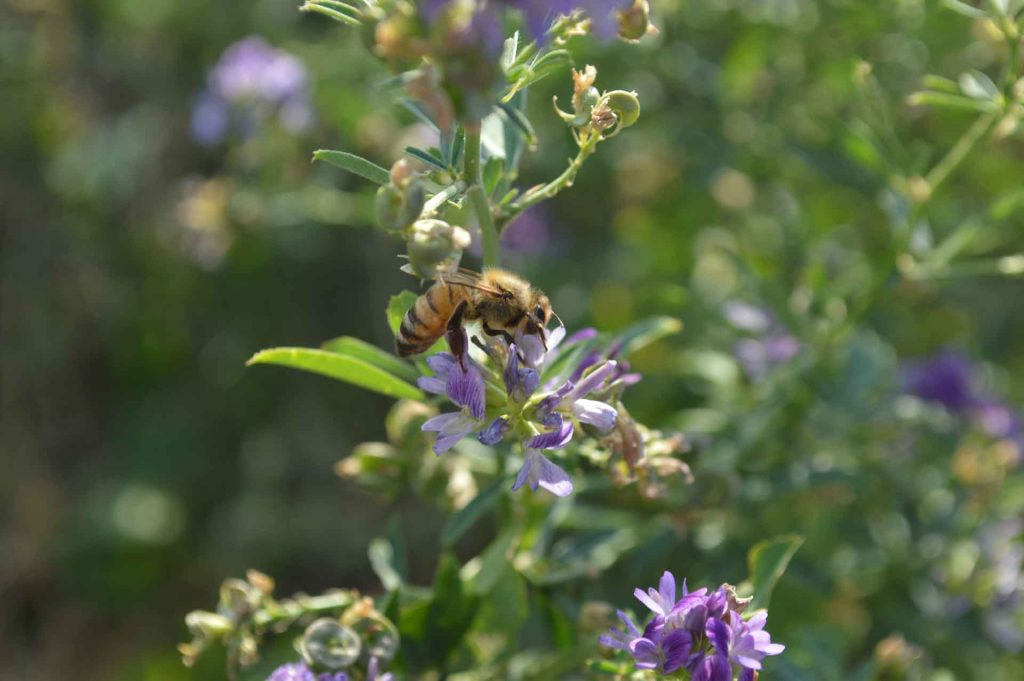
First, we put 60 bee colonies (i.e., hives) at six conventional and six organic spring wheat farms over two growing seasons (2014-2015) in Big Sandy, Montana, USA (Fig.4; see details in [5]). We found that bee colony growth rate, bee brood cells (eggs/larvae/pupae), and nectar stores (honey storing pots in bee colonies) were all greater in organic farms in both years, than in conventional farms (Fig. 5 & 6). Our results suggested that by increasing bee colony success, the greater floral resources (see Box #2-4) in organic farm provide better biodiversity-based ecosystem services even in the highly simplified agricultural landscapes. Second, we assessed the extent to which farming systems impact bee-flower networks (i.e., interactions between bees and flowers: more the better) on nine conventional and nine organic farms. Our results indicated that diversified organic farms had more connected (that are supposed to be more stable) and complex bee-flower interaction networks (Fig. 7; see details in [6]), compared to those of conventional farms.
In a separate study, we also assessed whether farming systems have a role on pest (wheat stem sawfly: a serious pest in Northern Great Plains wheat systems) infestation and parasitism. We collected winter wheat samples from adjacently located nine organic and nine conventional farms and compared infestation by wheat stem sawfly and subsequent parasitism across farming systems. Our results showed that organic farms had 75 percent lower wheat stem sawfly pest infestation than in conventional farms, which was due to a significantly higher number of parasitoids present in organic farms than in conventional farms. These results indicate that, by enhancing alternative sources of pollen and nectar via increased plant diversity, organic farms support more beneficial insects such as parasitoids and enhance pest regulation or ecosystem services (see details in [7-8]).
Box # 2: Are weeds always bad?
Weeds are universally known as one of the key limiting factors in organic production. Some conventional growers may even blame that the organic growers support more weeds in their farm, which could lead a problem to their neighboring conventional growers, too. While organic growers have been using several weed management practices such as mulching, weed fabric, soil solarization, tillage, organic approved herbicides, steam treatment, flaming, mowing or hoeing, mechanical weeding or hand pulling, there are always some weeds left in the farms. If the weeds are under economic injury level (i.e., not reducing crop yield) and non-invasive, we shouldn’t need any expensive tool to control weeds. And, the weeds under economic injury level, can in fact provide floral resources to beneficial insects such as bees, parasitoids, and generalists predators (see [5-8]). In return, bees provide pollination services to crops, vegetables, and wild flowers, whereas parasitoids provide pest regulation services by controlling crop pests. Additionally, since diversified organic farming is associated with crop rotation, cover cropping, and multiple cropping, farmland biodiversity is increased so that we can reap the benefits of biodiversity-based ecosystem services (i.e., pollination and pest regulation).
How is Agricultural Sustainability Related to Diversified Organic Farming?
Agricultural sustainability can be defined as an approach to food and fiber production that it is environmentally safe, ecologically balanced, economically viable, and socially acceptable, providing possible ecosystem services without compromising its availability to support future generations. To attain the goal of sustainability in farming systems it is required to recognize and promote the system’s existing ecological processes like nutrient/water cycling and energy flow within and between trophic levels (i.e., plants, herbivores, and predators) and incorporating farmers’ experiences and agro-ecological knowledges to create a diversified farming system. Continuously improving farm management strategies by learning from past experiences makes diversified organic farming more resilient and therefore more sustainable. Resilience is defined as a tendency of a system to retain its organizational structure and productivity following any external disturbances. For example, crop diversification can improve ecosystem resilience and agricultural sustainability in a variety of ways such as by enhancing pest suppression and reducing pathogen transmission. Such benefits point toward value of adopting diversified organic farming to improve agricultural sustainability, yet adoption has been slow in many parts of California and outside.

Box # 3: Fear of lower crop yield?
As a conventional farmer enjoying a good yield with heavy reliance on synthetic inputs, if you choose to adopt diversified organic systems you may suffer from yield loss initially. However, in the long run, this will not be the case. The crop yield and farm profit of diversified systems that follows mixed and rotational cropping with fewer external inputs could be either similar to, or greater than, those in the conventionally managed systems that follows higher agrochemical inputs [9]. In many cases farmers report an over-yield from the mixed crops, then growing a single crop. Most importantly, other ecosystem services (see, box # 1) provided by diversified systems are higher than those provided by intensified monoculture systems [10].
Box #4: Who else can/should help growers adopting diversified organic farming?
The public can also reap the benefits and services provided by the ecosystems that the growers manage. Federal/state agencies and university extensions can help growers and other stakeholders on why and how to adopt diversified organic farming and produce vital ecosystem services. For example, the federal government compensates farmers through its conservation reserve program (CRP), and in similar ways can support to diversified organic growers. The public has also demonstrated a willingness to pay a high price or premium for the organic products whether they are produced from monoculture or diversified farming. As an example, we are well-aware that local farmer’s markets are increasingly popular, despite their higher prices compared to the grocery stores. However, for this, the public should also be aware of the ecosystem services that they have been continuously taking for granted.
Summary:
Diversified organic farming systems, compared to monoculture-based conventional systems, do not use synthetic insecticides and herbicides and often support a greater diversity of plant species. These agroecosystems also support greater abundance and higher species richness of pollinators and pest regulating beneficial insects like predators and parasitoids, ultimately providing greater ecological services to farmers as well as to the public [9-11]. Hence, following diversified farming, you can minimize future risk in your agricultural production since you will have some crops left to harvest even if one of your crops is completely damaged by a pest outbreak.

Diversified organic farming is not the same as ecologically-based farming but close to it. Ecologically-based farming is an approach to agriculture that relies on augmenting or intensifying ecological processes to provide the functions necessary for sustained production, thus helping to reduce excessive use of external chemical and mechanical inputs. Examples of ecologically-based diversified farming practices include integrated crop-livestock production, crop rotations, mixed cropping, biological control of pests, reduced or no-tillage, and cover cropping. Ecologically-based diversified farming aims to be multi-beneficial by providing food production, economic well-being, environmental benefits, and important ecosystem services such as pollination, natural pest control, nutrient and water cycling, increased soil organic matter, pollution control, and erosion control. While all diversified organic farming may not provide these ecosystem services, majority of them do.
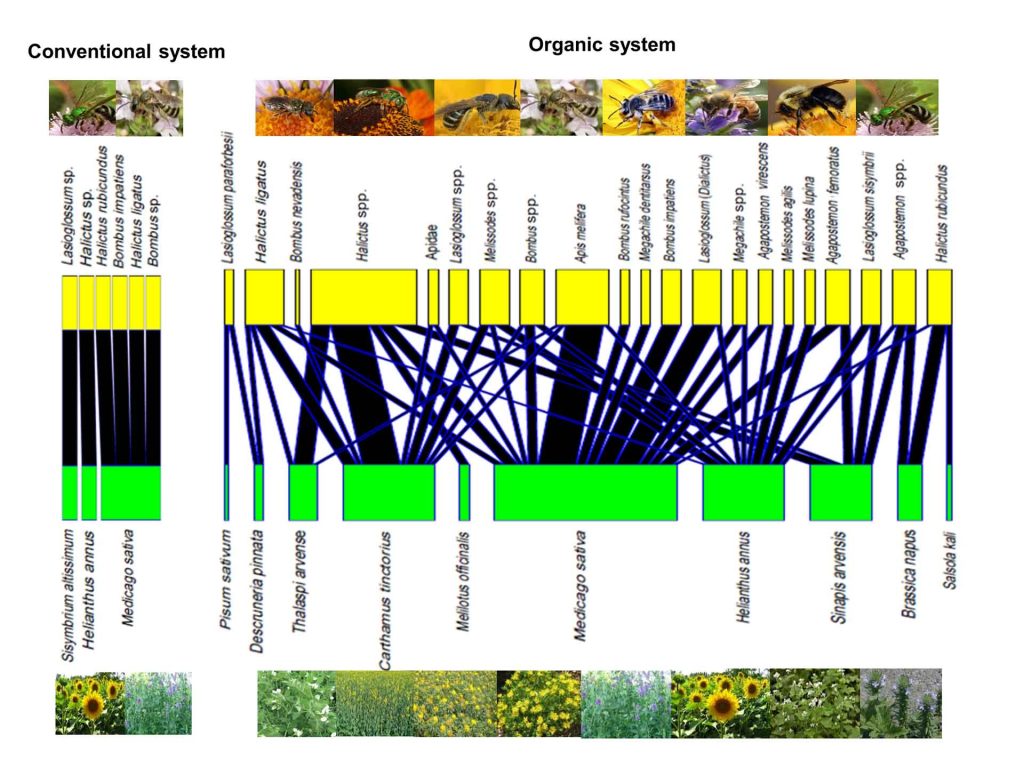
To adopt diversified organic farming, you can follow these steps:
- Consult with university extension professors, federal/state employees, and county extension agents.
- Consult with other farmers inside and outside the state/country who have already adopted and benefited from the diversified organic systems.
- Reduce excessive use of chemical fertilizers and pesticides and replace them with cover crops and crop rotation to enhance soil fertility and break pest cycles.
- Start mix cropping, intercropping, and integrated crop-livestock production whenever possible.
- Plant hedgerows, trees, and native wild flowers and apportion uncultivated land around your farm, to provide food and habitat for the beneficial organisms at your agricultural landscape.
Finally, you do not need to start converting all your land into diversified organic at once, but you can begin adopting some of its elements. Gradually, you can learn from your own experiments or experiences and decide whether you want to pursue the quest of diversified organic farming and enhance ecosystem services for the agricultural sustainability.
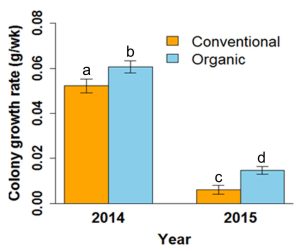
Acknowledgements:
The projects mentioned in this article were funded mainly by United States Department of Agriculture (USDA) Organic Research and Extension Initiative (OREI) to F. D. Menalled, and partly by OCIA-International to S. Adhikari).
References:
- 1. Assessment, M. 2005. Ecosystems and human well-being: wetlands and water. World Resour. institute, Washington DC.
- Gallai, N., Salles, J.M., Settele, J., Vaission, B.E. 2009. Economic valuation of the vulnerability of world agriculture confronted with pollinator decline. Ecol. Econ. 68: 810–821.
- USDA. 2007. Agriculture Secretary Mike Johanns addressed the problem of honeybee colony collapse disorder. USDA Satellite News Feed July 5, 2007.
- Ishaq SL, Johnson SP, Miller ZJ, Lehnhoff EA, Olivo S, Yeoman CJ, et al. 2017. Impact of cropping systems, soil inoculum, and plant species identity on soil bacterial community structure. Microb Ecol. 73: 417–434.
- Adhikari, S.; Burkle, L.A.; O’Neill, K.M.; Weaver, D.K.; Menalled, F.D. 2019. Dryland organic farming increases floral resources and bee colony success in highly simplified agricultural landscapes. Agric. Ecosyst. Environ. 270–271: 9–18
- Adhikari, S.; Burkle, L.A.; O’Neill, K.M.; Weaver, D.K.; Delphia, C.M.; Menalled, F.D. 2019. Dryland Organic Farming Partially Offsets Negative Effects of Highly Simplified Agricultural Landscapes on Forbs, Bees, and Bee–Flower Networks. Environ. Entomol. doi:10.1093/ee/nvz056.
- Adhikari, S., Seipel, T., Menalled, F.D., Weaver, D.K. 2018. Farming system and wheat cultivar affect infestation of, and parasitism on, Cephus cinctus in the Northern Great Plains. Pest Manag. Sci. 74: 2480–2487.
- Adhikari, S., Adhikari, A., Weaver, D.K, Bekkerman, A, Menalled, F.D. 2019. Impacts of agricultural management systems on biodiversity and ecosystem services in highly simplified dryland landscapes. Sustainability, 11, 3223.
- Davis, A.S., Hill, J.D., Chase, C.A., Johanns, A. M., Liebman, M. 2012. Increasing cropping system diversity balances productivity, profitability and environmental health. PLoS ONE, 7 p. e47149.
- S.P. Syswerda, G.P. Robertson. 2014. Ecosystem services along a management gradient in Michigan (USA) cropping systems. Agric. Ecosyst. Environ. 189: 28–35.
- Kremen, C. Iles, A. and Bacon, C.M. (2012). Diversified Farming Systems: An agroecological, systems-based alternative to modern industrial agriculture. Ecol. Soc. 17(4): 44.

